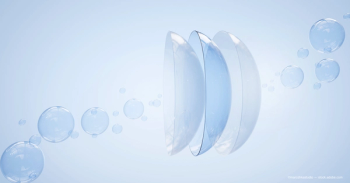
Getting to the root of dry eye: Know clues to MGD, Sjögren’s diagnosis
Clinical clues shine light on differences between Sjögren’s Syndrome and Meibomian Gland Dysfunction in DED.
A
Now, a pair of surveys could provide some additional insight for patients who present with issues that could prove to be dry eye, including the surveys include the
The OSDI and SPEED questionnaires cannot be used interchangeably. Finis et. al. noted that SPEED levels seemed to correlate more with the parameters of evaporative dry eye, the OSDI values correlate more with parameters of aqueous tear-deficient dry eye. 1
In SPEED, a score of 0 to 4 indicates mild dry eye, 5 to 7 indicates moderate dry eye, and 8 and greater indicates severe dry eye.
The majority of evaporative dry eye is caused by
Focus on lids
MGD symptoms are nearly identical to dry eye syndrome, with patients complaining of dryness, irritation, redness, and blurred vision.
To diagnose MGD, the
First, look at the patient’s face. Does the patient have rosacea or chalazia? Both are associated with MGD-related dry eye.2 If no rosacea or chalazia are present, evaluate the quality of the tear film and look for oily debris. A rapid tear break-up time of less than five seconds is another indicator of MGD.3
Clinicians should also check the number of glands present through retroillumination. A person with normal functioning glands should have about 40 glands in their upper eyelid and about 30 in their lower eyelid. Patients with severe MGD will have a gland dropout.4
The most telling sign of MGD is the health of the meibomian glands themselves. Dry eye or MGD evaluations should include examining the eyelids and expressing the meibomian glands.
Evaluate lid margin
TFOS recommends evaluating the lid margin under the slit lamp and gently pressing on the meibomian glands using a Q-Tip or commercial grade tool. For people with healthy meibomian glands, the meibum will be clear and oily and express easily.
Patients with abnormal functioning meibum glands will have poor meibum expression that is thick and discolored.
In advanced cases of MGD, the meibum will resemble a toothpaste-like white ribbon. In the most extreme cases of obstructive MGD, there will be a lack of meibum secretion after application of moderate pressure.4
On the opposite end of the spectrum, patients could have hypersecretion of meibum, which is characterized by the release of a large volume of meibomian lipid at the lid margin in response to pressure.
These patients will often present with a foam along the edge of the eyelids.
If scrubs, lid warming, and warm compresses/massaging are ineffective, there are two primary treatments for MGD: LipiFlow (Johnson & Johnson Vision) and the iLux system (Alcon). The two are expected to begin a head-to-head study in late July. Other interventions include intense pulsed light or punctal plugs.
Symptoms of Sjögren’s syndrome
As with MGD, there is no single diagnostic test for Sjögren’s syndrome, and a diagnosis can only be made based on a combination of symptoms and test results.
Patients with Sjögren’s syndrome typically complain of eyes that burn, itch, or feel gritty. However, these patients are likely to have other non-ocular symptoms such as a sore, cracked tongue; dry mouth; joint pain; skin rashes; or a persistent dry cough.5
Symptoms are often nonspecific and develop gradually; patients may not be aware they have them and may not readily mention them during an eye exam. For patients with complaints of dry eye, specific questions during the examination beyond the initial questionnaire can help narrow the diagnosis; these include:
• Does patient have trouble swallowing?
• Does patient have difficulty speaking?
• Has the patient had a daily feeling of dry mouth for more than three months?
• Does the patient have to wake up at night to drink water because of dry mouth?
Determining if a patient with dry eye has concomitant dry mouth symptoms is a cornerstone to diagnosing Sjögren’s. Studies have found that the combined symptoms of dry mouth, sore mouth, and dry eyes correctly classified 93% of patients with Sjögren’s.6
Sjögren’s should be suspected in all aqueous-deficient dry eye patients, and the
Schirmer's test results of < 5 mm is indicative of aqueous deficiency, 5 to 10 mm is considered borderline, and > 10 mm is considered normal.
If Sjögren’s syndrome is suspected, clinical work-up should include minor salivary gland biopsy, lacrimal gland biopsy, systemic endocrine findings, salivary function tests, and serological tests for autoantibody biomarkers.
Traditional biomarkers include anti-SS-A/Ro, anti-SS-B/La, and rheumatoid factor; novel biomarkers include salivary protein-1, carbonic anhydrase VI, and parotid secretory protein.
The Sjögren’s Syndrome Foundation notes that no “cure” exists for Sjögren’s, but treatments can include over-the-counter eye drops, prescription dry eye medications such as Restasis (topical cyclosporine 0.05%, Allergan) or Xiidra (lifitegrast, Novartis), or Lacrisert (hydroxypropyl cellulose ophthalmic insert, Bausch + Lomb).
References:
1. Finis D, Pischel N, Konig C, et al. [Comparison of the OSDI and SPEED questionnaires for the evaluation of dry eye disease in clinical routine]. Ophthalmologe 2014;111(11):1050-6.
2. Matossian C, McDonald M, Donaldson KE, et al. Dry Eye Disease: Consideration for Women's Health. J Womens Health (Larchmt) 2019.
3. Willcox MDP, Argueso P, Georgiev GA, et al. TFOS DEWS II Tear Film Report. Ocul Surf 2017;15(3):366-403.
4. Wolffsohn JS, Arita R, Chalmers R, et al. TFOS DEWS II Diagnostic Methodology report. Ocul Surf 2017;15(3):539-74.
5. Coursey TG, de Paiva CS. Managing Sjogren's Syndrome and non-Sjogren Syndrome dry eye with anti-inflammatory therapy. Clin Ophthalmol 2014;8:1447-58.
6. Al-Hashimi I, Khuder S, Haghighat N, Zipp M. Frequency and predictive value of the clinical manifestations in Sjogren's syndrome. J Oral Pathol Med 2001;30(1):1-6.
Newsletter
Don’t miss out—get Ophthalmology Times updates on the latest clinical advancements and expert interviews, straight to your inbox.













































